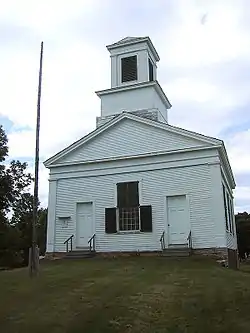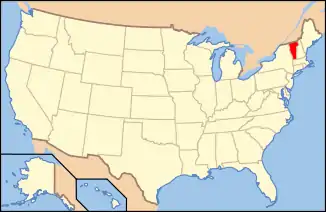Braintree, Vermont | |
|---|---|
Town | |
 Braintree Meeting House, Braintree, Vermont | |
 Located in Orange County, Vermont | |
 Location of Vermont with the U.S.A. | |
| Coordinates: 43°57′42″N 72°42′18″W / 43.96167°N 72.70500°W | |
| Country | United States |
| State | Vermont |
| County | Orange |
| Chartered | 1781 (Vermont) |
| Communities | Braintree Hill East Braintree West Braintree |
| Area | |
| • Total | 38.3 sq mi (99.3 km2) |
| • Land | 38.3 sq mi (99.2 km2) |
| • Water | 0.04 sq mi (0.1 km2) |
| Elevation | 777 ft (295 m) |
| Population (2020) | |
| • Total | 1,207 |
| • Density | 32/sq mi (12.2/km2) |
| • Households | 482 |
| • Families | 325 |
| Time zone | UTC-5 (EST) |
| • Summer (DST) | UTC-4 (EDT) |
| ZIP code | 05060 |
| Area code | 802 |
| FIPS code | 50-07600[1] |
| GNIS feature ID | 1462047[2] |
| Website | braintreevt.com |
Braintree is a town in Orange County, Vermont, United States created by Vermont charter on August 1, 1781. The population was 1,207 at the 2020 census.[3] Braintree includes the places Braintree Center, Braintree Hill, East Braintree, West Braintree, Peth and Snowsville.
Geography
According to the United States Census Bureau, the town has a total area of 38.3 square miles (99.2 km2), of which 38.3 square miles (99.1 km2) is land and 0.04 square mile (0.1 km2) (0.10%) is water.
Demographics
| Census | Pop. | Note | %± |
|---|---|---|---|
| 1790 | 221 | — | |
| 1800 | 531 | 140.3% | |
| 1810 | 850 | 60.1% | |
| 1820 | 1,033 | 21.5% | |
| 1830 | 1,209 | 17.0% | |
| 1840 | 1,332 | 10.2% | |
| 1850 | 1,228 | −7.8% | |
| 1860 | 1,225 | −0.2% | |
| 1870 | 1,066 | −13.0% | |
| 1880 | 1,051 | −1.4% | |
| 1890 | 854 | −18.7% | |
| 1900 | 776 | −9.1% | |
| 1910 | 760 | −2.1% | |
| 1920 | 707 | −7.0% | |
| 1930 | 635 | −10.2% | |
| 1940 | 648 | 2.0% | |
| 1950 | 626 | −3.4% | |
| 1960 | 536 | −14.4% | |
| 1970 | 751 | 40.1% | |
| 1980 | 1,065 | 41.8% | |
| 1990 | 1,174 | 10.2% | |
| 2000 | 1,194 | 1.7% | |
| 2010 | 1,246 | 4.4% | |
| 2020 | 1,207 | −3.1% | |
| U.S. Decennial Census[4] | |||
As of the census[1] of 2000, there were 1,194 people, 482 households, and 325 families residing in the town. The population density was 31.2 people per square mile (12.0/km2). There were 567 housing units at an average density of 14.8 per square mile (5.7/km2). The racial makeup of the town was 98.41% White, 0.34% Native American, 0.17% Asian, 0.17% Pacific Islander, 0.25% from other races, and 0.67% from two or more races. Hispanic or Latino of any race were 0.50% of the population.
There were 482 households, out of which 32.8% had children under the age of 18 living with them, 51.9% were married couples living together, 10.4% had a female householder with no husband present, and 32.4% were non-families. 24.7% of all households were made up of individuals, and 11.2% had someone living alone who was 65 years of age or older. The average household size was 2.48 and the average family size was 2.94.
In the town, the population was spread out, with 25.3% under the age of 18, 6.9% from 18 to 24, 28.0% from 25 to 44, 27.3% from 45 to 64, and 12.6% who were 65 years of age or older. The median age was 40 years. For every 100 females, there were 99.3 males. For every 100 females age 18 and over, there were 97.3 males.
The median income for a household in the town was $37,232, and the median income for a family was $45,357. Males had a median income of $30,707 versus $21,411 for females. The per capita income for the town was $16,480. About 2.7% of families and 6.5% of the population were below the poverty line, including 5.2% of those under age 18 and 4.3% of those age 65 or over.
Notable people
- Edwin Flint, member of the Wisconsin Senate[5]
- Waldo Flint, member of the Wisconsin Senate[6]
- Jefferson P. Kidder, lawyer, jurist and Lieutenant Governor of Vermont[7]
- Eleazer Parmly, first provost of the University of Maryland School of Dentistry[8]
- Francis V. Randall, Union Army colonel during the American Civil War[9]
- Gurdon P. Randall, architect[10]
- J. J. R. Randall, architect[11]
- Daniel Robbins, art historian[12]
References
- 1 2 "U.S. Census website". United States Census Bureau. Retrieved January 31, 2008.
- ↑ "US Board on Geographic Names". United States Geological Survey. October 25, 2007. Retrieved January 31, 2008.
- ↑ "Census - Geography Profile: Braintree town, Orange County, Vermont". Retrieved December 28, 2021.
- ↑ "U.S. Decennial Census". United States Census Bureau. Retrieved May 16, 2015.
- ↑ Associate Alumni of the University of Vermont (1895). University of Vermont Obituary Record. Vol. 1. Burlington, VT: University of Vermont. pp. 56–57 – via Google Books.
- ↑ Bashford, R. M. (1876). The Legislative Manual of the State of Wisconsin. Madison, WI: E. B. Bolens. p. 467 – via Google Books.
- ↑ Ellis, William Arba (1911). Norwich University, 1819-1911: Her History, Her Graduates, Her Roll of Honor. Vol. 3. Montpelier, VT: Capital City Press. p. 156 – via Google Books.
- ↑ Lesinski, Chris (April 2, 2015). "Early Settlers of Braintree Became Rich & Famous". Herald of Randolph. Randolph, VT.
- ↑ Ellis, William Arba (1898). Norwich University: Her History, Her Graduates, Her Roll of Honor. Concord, NH: Rumford Press. p. 115 – via Google Books.
- ↑ Seventh, Eighth, Ninth, and Tenth Annual Reports of the Illinois Association of the Sons of Vermont. Chicago, IL: S. D. Childs & Co. 1886. p. 65 – via Google Books.
- ↑ Randall, E. H. (1879). Genealogy of a Branch of the Randall Family, 1666-1906 (PDF). Norwich, NY: Office of the Chenango Union. p. 8.
- ↑ Kimmelman, Michael (January 18, 1995). "Daniel Robbins, 62; Was Art Historian And a Modernist". The New York Times. New York, NY.
